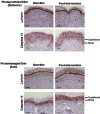Pilot study on the bioactivity of vitamin d in the skin after oral supplementation
- PMID: 25835512
- PMCID: PMC4511849
- DOI: 10.1158/1940-6207.CAPR-14-0280
Pilot study on the bioactivity of vitamin d in the skin after oral supplementation
Abstract
Laboratory studies suggest that vitamin D (VD) supplementation inhibits skin carcinogenesis. However, epidemiologic studies report mixed findings in the association between circulating VD levels and skin cancer risk. We conducted a clinical study to determine whether oral cholecalciferol supplementation would exert direct bioactivity in human skin through modulation of the VD receptor (VDR). We enrolled 25 individuals with serum 25-hydroxyvitamin-D levels <30 ng/mL and with skin photodamage to take 50,000 IU of cholecalciferol biweekly for 8 to 9 weeks. Then, we obtained baseline and end-of-study skin biopsies from photodamaged (PD) and photoprotected (PP) skin, and from benign nevi (BN) and tested for mRNA expression of VDR and cytochrome P450-24 (CYP24), and markers of keratinocytic differentiation. High-dose cholecalciferol supplementation significantly elevated circulating levels of 25-hydroxyvitamin-D (P < 0.0001) and 1,25-dihydroxyvitamin-D (P < 0.0001). VDR expression in PD- and PP-skin showed minimum changes after supplementation. CYP24 expression in PD- and PP-skin was increased after supplementation by 186%, P = 0.08, and 134%, P = 0.07, respectively. In BNs from 11 participants, a trend for higher VDR and CYP24 expression was observed (average of 20%, P = 0.08, and 544%, P = 0.09, respectively). Caspase-14 expression at the basal layer in PD skin samples was the only epidermal differentiation marker that was significantly increased (49%, P < 0.0001). High-dose cholecalciferol supplementation raised serum VD metabolite levels concurrently with CYP24 mRNA and caspase-14 levels in the skin. Our findings of significant variability in the range of VDR and CYP24 expression across study samples represent an important consideration in studies evaluating the role of VD as a skin cancer chemopreventive agent.
©2015 American Association for Cancer Research.
Figures

Similar articles
-
A Prospective Study to Evaluate the Possible Role of Cholecalciferol Supplementation on Autoimmunity in Hashimoto's Thyroiditis.J Assoc Physicians India. 2023 Jan;71(1):1. J Assoc Physicians India. 2023. PMID: 37116030 Clinical Trial.
-
High-dose vitamin D supplementation does not improve outcome in a cutaneous melanoma population: results of a randomized double-blind placebo-controlled study (ViDMe trial).Br J Dermatol. 2024 Nov 18;191(6):886-896. doi: 10.1093/bjd/ljae257. Br J Dermatol. 2024. PMID: 38913652 Clinical Trial.
-
A randomized study on the effect of vitamin D₃ supplementation on skeletal muscle morphology and vitamin D receptor concentration in older women.J Clin Endocrinol Metab. 2013 Dec;98(12):E1927-35. doi: 10.1210/jc.2013-2820. Epub 2013 Oct 9. J Clin Endocrinol Metab. 2013. PMID: 24108316 Free PMC article. Clinical Trial.
-
The Impact of Vitamin D and L-Cysteine Co-Supplementation on Upregulating Glutathione and Vitamin D-Metabolizing Genes and in the Treatment of Circulating 25-Hydroxy Vitamin D Deficiency.Nutrients. 2024 Jun 24;16(13):2004. doi: 10.3390/nu16132004. Nutrients. 2024. PMID: 38999752 Free PMC article. Review.
-
Vitamin D supplementation for sickle cell disease.Cochrane Database Syst Rev. 2020 May 28;5(5):CD010858. doi: 10.1002/14651858.CD010858.pub3. Cochrane Database Syst Rev. 2020. PMID: 32462740 Free PMC article.
Cited by
-
Updates in clinical trial-explored chemopreventive agents for cutaneous melanoma: mechanisms affecting melanocytes.Melanoma Manag. 2025 May 13;12(1):2505400. doi: 10.1080/20450885.2025.2505400. Epub 2025 May 16. Melanoma Manag. 2025. PMID: 40376946 Free PMC article. Review.
-
Recent Advances in Clinical Research for Skin Cancer Chemoprevention.Cancers (Basel). 2023 Jul 27;15(15):3819. doi: 10.3390/cancers15153819. Cancers (Basel). 2023. PMID: 37568635 Free PMC article. Review.
-
Unconventional Remedies for Squamous Cell Carcinoma: A Journey into Alternative Treatments.Curr Pharm Biotechnol. 2024;25(16):2047-2059. doi: 10.2174/0113892010286715240119061108. Curr Pharm Biotechnol. 2024. PMID: 38347792 Review.
-
Relationship between Vitamin D Status and Striae Distensae: A Case-Referent Study.Dermatol Res Pract. 2015;2015:640482. doi: 10.1155/2015/640482. Epub 2015 Nov 9. Dermatol Res Pract. 2015. PMID: 26635874 Free PMC article.
-
Chemoprevention agents for melanoma: A path forward into phase 3 clinical trials.Cancer. 2019 Jan 1;125(1):18-44. doi: 10.1002/cncr.31719. Epub 2018 Oct 3. Cancer. 2019. PMID: 30281145 Free PMC article. Review.
References
-
- Gandini S, Raimondi S, Gnagnarella P, Dore JF, Maisonneuve P, Testori A. Vitamin D and skin cancer: a meta-analysis. Eur J Cancer. 2009;45:634–41. - PubMed
Publication types
MeSH terms
Substances
Grants and funding
LinkOut - more resources
Full Text Sources
Medical
Miscellaneous

